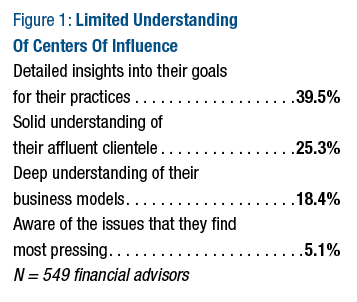Central to being effective cultivating centers of influence is developing an in-depth understanding of them and their business models. Only then is it possible for you to provide viable value-added expertise to them. However, what’s more often the case is that financial advisors aren’t committed to or capable of effectively profiling the various professionals they’re looking to for affluent client referrals.
In a study of 549 financial advisors, it is clear that very few of them have a well-rounded and deep understanding of the centers of influence they’re seeking to obtain affluent clients from.
About two-fifths report being aware of the goals—personal or professional—of the centers of influence they’re pursuing. A quarter of the financial advisors say they have a solid understanding of the other professionals’ affluent clientele. Less than one in five of the financial advisors surveyed claim to have a deep understanding of the business model of these other professionals. Just about 5% of financial advisors report they’re aware of the critical concerns impacting these centers of influence.
The Assessment Instrument
What’s evident by evaluating the best networking practices of both ultra-successful professionals and self-made millionaires is that these insights and perspectives are core to building very powerful and meaningful relationships with centers of influence. Based on these best practices, we developed an assessment instrument that captures the requisite critical information.
There are five broad components of the assessment instrument. Let’s now consider—in broad brushes with a few examples—these components.
Attributes are the central and often defining characteristics of the person. We usually look to address:
Demographics
• Personal factors.
• Years in business.
Professional situation
• Technical expertise and particular competencies.
• Strengths and weaknesses.
To ensure a solid and ongoing alignment of interests, you’ll have to cognize the center of influence’s professional situation. You’ll also need to be keenly aware of his or her goals (see below), as well as how these goals are actualized based on the professional’s particular business model.
Contacts are the people the individual knows and can access. There are many components to this category, and all these facets need to be ascertained. The most pressing and informative components are:
• Nature of contacts.
• Source of contacts.
• Strength of contacts.
• Connector capabilities.








